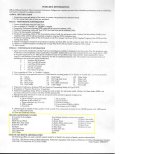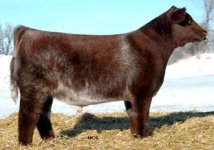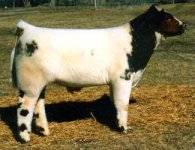kfacres
Well-known member
leanbeef said:outspoken said:Many years ago, a very high quality set of folks who show the local fair curcuit showed a blue roan purebred Sim heifer. I always swore she must have been bred up from some shorthorn blood-- but they swore she was purebred Sim, and had zero shorthorn blood in her.
Of course, since they also raise shorthorns, I kinda doubted them-- maybe the wrong straw of semen, or the bull jumped the fence.. but I never called them out.. They'd never done anything wrong to me to doubt them.. but they swore that heifer was purebred.
Well, with an open herd book, all purebred cattle have SOMETHING back in the wood pile, so to speak. The definition of "Purebred" means the animal's ancestry goes back to other stock, and the animal was bred up from cattle from one or more other breeds, even possibly commercial crossbred cattle! And in that case, there may not be anyone who can tell you what breed or breeds make up the history of the family.
A purebred is at least three generations back to a purebred Simmental parent, and though the rules and guidelines have changed a little over the years and are less strict now than they used to be, it's still three generations to purebred. The blue roan heifer I'm talking about goes back four generations to a 3/4 blood red, blaze faced Galant daughter out of a black baldy cow. Her mother's sire I know less about, but according to the papers, was out of a fullblood bull (meaning import bloodlines from Europe...no "breeding up" or other breeds involved) and was several generations of purebreds on the dam's side back to a cow considered to be 3/4 SM 1/4 Angus... All the bulls on the top side were fullbloods. The funny thing about this whole story to me was that this cow's grandmother-out of a solid red blaze faced 3/4 SM cow and a yellow, fullblood SM bull--was a lemon yellow baldy with goggle eyes and two very strangely shaped white spots on one side...they were shaped like bits of biscuit dough left over after your Grandma cut out the biscuits. I always found her markings interesting and strange. Her daughter was a blood red blaze faced heifer with a white belt that came up from her belly all the way across her loin and a red saddle coming back into the belt from the top of her shoulders. Even stranger than her mother... The red baldy was that cow's daughter and was plainly marked...I remember hoping for something more interesting and getting a plain red baldy with one red eye. I still have no idea where the roan came from!
I did buy another solid black cow in Kentucky once who was bred to DS Zinger when I bought her. The calf was born solid black, and by weaning time, I had noticed a few white hairs in the middle of her face. I ended up consigning her to the North American sale in Louisville, and she eventually roaned out all over. I'm pretty sure the guy who bought her thinks she was part Shorthorn, and I didn't BREED that heifer so all I had to go on was that I bought her mother bred to Zinger...I never knew quite what to make of that situation either, but as far as the heifer was made, she definitely looked like a Simmie...not a Shorthorn.
These people claimed this heifer DID NOT trace back to shorthorn blood=- just as you claim... She was straight fullblood Sim and Angus.



